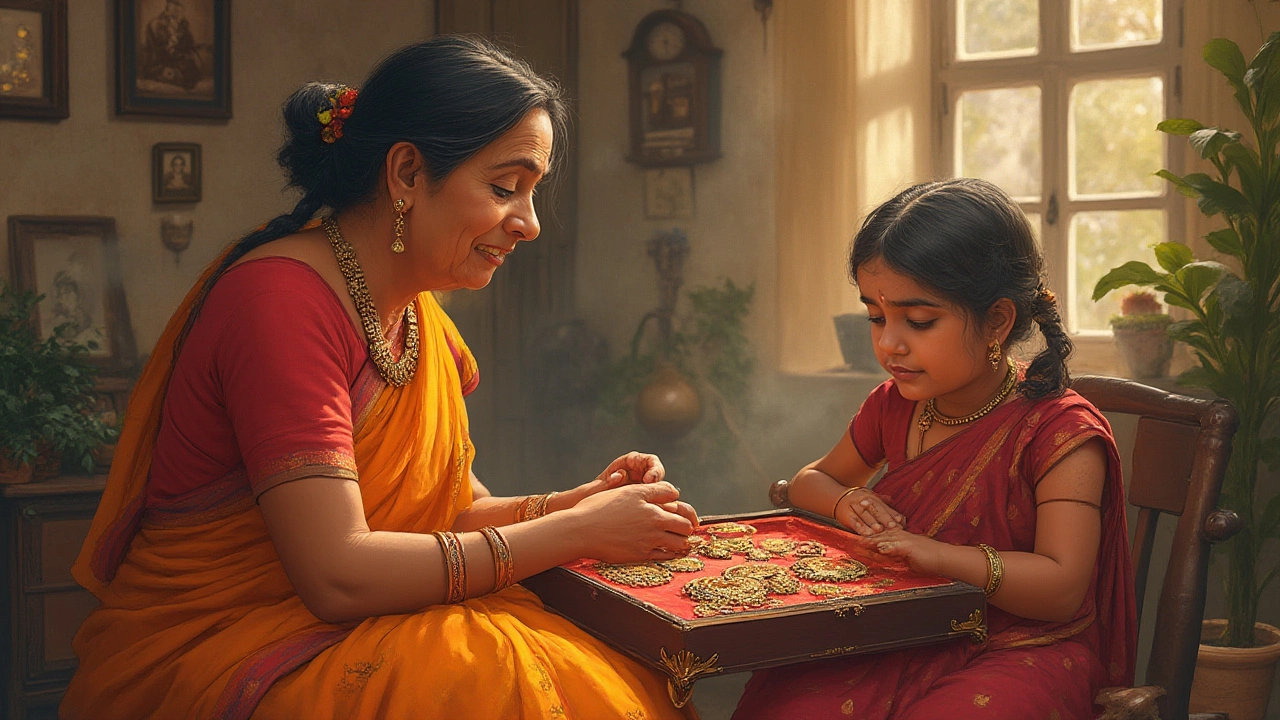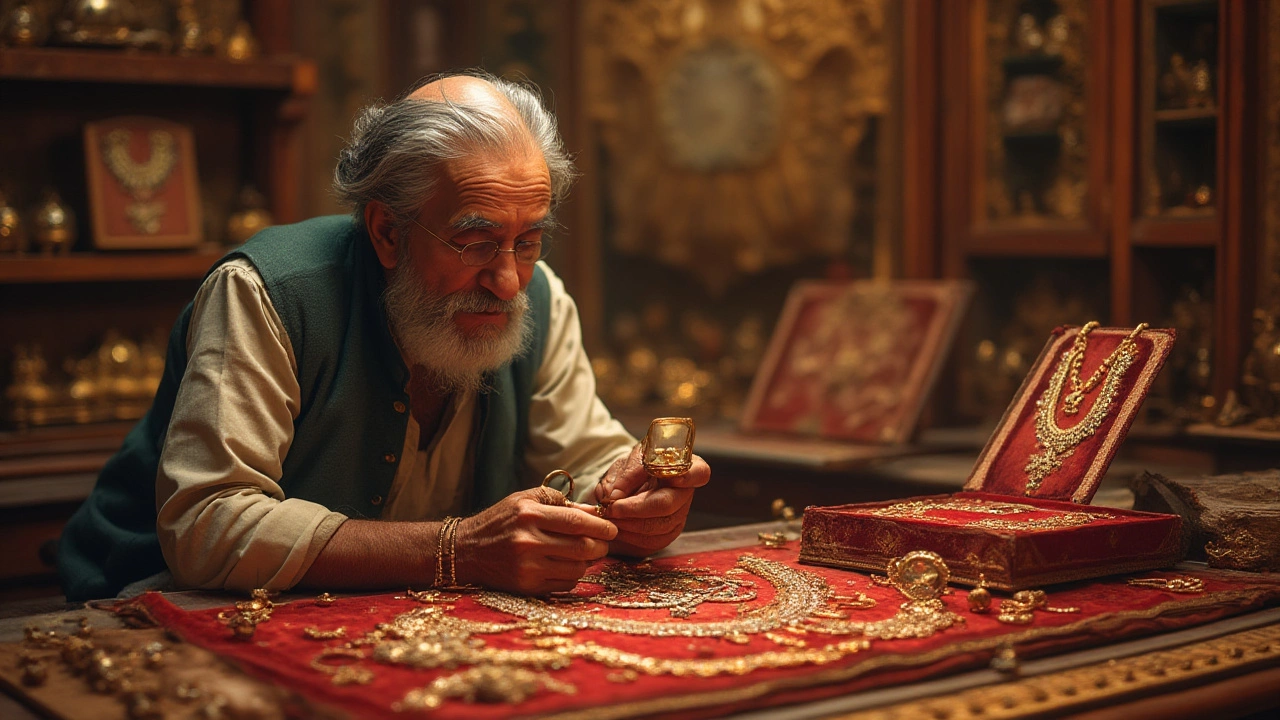Imagine digging up a ring at the bottom of your grandma’s jewelry box, only to discover it might be worth a small fortune. But wait—before you get excited, you’re left with one burning question: at what age is jewelry actually considered antique? With everyone from local sellers to big auction houses tossing around the word ‘antique’ like spare change, it’s tough to know what qualifies. There’s no magical portal that opens when jewelry hits a certain age, but there is a well-accepted cutoff (hint: it’s older than the bowling league you joined in your early twenties).
The Magic Number: When Does Jewelry Become Antique?
So, let’s cut straight to it: in the jewelry world, the word “antique” is more than just a fancy label. There’s a concrete number—the 100-year rule. If a piece of jewelry is at least 100 years old, it typically earns the coveted title of antique. Auction houses like Christie’s, Sotheby’s, and countless indie dealers stick to this standard. That means in 2025, any jewelry made in or before 1925 gets the antique tag.
This isn’t just some arbitrary rule someone made up in their garage. The 100-year benchmark helps keep things clear and gives serious collectors, sellers, and buyers an even playing field. Sure, you’ll meet some sellers who stretch the truth, slapping “antique” on pieces from the 1970s or 80s. But real experts—those vetted at appraisers’ conferences or in the backrooms of London—will laugh that off.
Let’s see how major organizations define antique jewelry:
- International Society of Appraisers: 100 years or older.
- U.S. Customs & Border Protection: 100 years or older for legal import/export labeling.
- Most luxury auction houses: Stick to the century rule for museums, collectors, and insurance.
Now, don’t confuse antique with “vintage.” Vintage jewelry covers items roughly 20–99 years old, like glamorous Art Deco pieces from the 1930s or heavy gold chains from the disco era. Modern jewelry is anything younger.
Here’s a quick comparison:
| Term | Age | Typical Example |
|---|---|---|
| Modern | Post-1980s | Minimalist white-gold bands |
| Vintage | 20–99 years | 1970s boho turquoise rings |
| Antique | 100+ years | Edwardian diamond brooches |
Why 100 years? That number’s got some serious history. It became the standard across art, furniture, and collectibles, signaling not just age but a slice of another era—a piece that’s survived two World Wars, swinging style changes, crazy technology leaps, and probably more than a few family squabbles.
So next time you’re sifting through jewelry—yours or someone else’s—pull out a calculator. Just because a brooch looks old doesn’t mean it’s truly antique. Turn it over in your hand, google the style, check the hallmarks, and if it’s pushing that triple-digit birthday, congrats: you’ve found something that earns the antique crown.
Spotting True Antiques: Signs and Tricks of the Trade
So you’ve got a family heirloom or a flea market find. How do you know if it’s truly antique and not just pretending? Experts use a combination of clues—materials, craftsmanship, marks, and style—to nail down a piece’s age.
First, check the materials. If you see plastic or modern alloys (like titanium), that’s usually an immediate red flag. True antiques lean on gold, silver, platinum, natural gemstones, and sometimes older alternatives like pinchbeck or steel. Platinum didn't become widely used until the 20th century, so plenty of Victorian pieces won’t have it. Bakelite or celluloid started appearing in jewelry by the early 1900s, but even then, only in newer “vintage” designs.
Craftsmanship is another dead giveaway. Modern jewelry is often machine-made, while antiques show signs of handwork. You might find small imperfections, hand-cut stones, uneven settings, or old-fashioned clasps. For example, a true Victorian locket may have a hand-engraved floral pattern, complete with tiny, uneven details from a craftsman’s steady hand. If it’s too perfect, be suspicious.
Look for hallmarks and maker’s marks. Most countries have marking systems that changed over time. British silver, for example, uses stamps that date all the way back to the 1300s, and you can pinpoint the year with the right chart. French jewelry often carries a tiny eagle’s head for 18k gold, and the symbols used change every few generations. U.S. jewelry marks got more standardized after 1906, thanks to the National Stamping Act. Even the type of script—blocky, flowing, or even misspelled—can point to a period.
Styles matter too. Each era has its vibe. Georgian pieces (1714–1837) are rare, loaded with delicate filigree and old-cut diamonds. Victorian jewelry (1837–1901) tells stories with symbolic motifs: snakes for eternal love, knots for friendship, lockets for mourning. Edwardian (1901–1915) is usually platinum and lace-like, super elegant. Art Deco (1920s–30s) is all jazz and geometry, but be careful—it’s vintage now, not antique, unless it’s edging over the 100-year mark.
- Look for wear in strange places: If a ring is supposed to be 150 years old but looks untouched, something’s fishy.
- Check the back and inside: Hand-scribed initials, old repairs, or even hairwork (yes, people used to weave loved ones’ hair into jewels!) can all signal authenticity.
- Feel the weight: Antique gold and silver pieces often weigh more because older alloys were purer and pieces were crafted to last.
If in doubt, invest in a cheap jeweler’s loupe and spend an afternoon playing detective. Sites like Antique Jewelry University or the Hallmark Research Institute offer free databases to help you match marks and styles. And if you’re still lost, a certified appraiser or local expert can clue you in—and potentially break some hearts if that “antique” cameo turns out to be a 1970s resin repro.

Common Myths About Antique Jewelry (And How Not to Get Burned)
The antique jewelry market is full of old wives’ tales, half-truths, and wishful thinking. Want to avoid rookie mistakes or sales tricks? Here are some of the most common myths you’ll encounter—and the real scoop from people who’ve been in the trenches.
Myth: Anything that looks old must be antique. Plenty of modern jewelers copy vintage and antique styles down to the tiniest detail. Reproductions can even be made with real gold and diamonds. Just because a necklace drips with Edwardian elegance or Victorian gloom doesn’t guarantee it’s actually from that era. Always check for signs of newer manufacture—highly regular clasps, bright white solder marks, or suspiciously perfect stones.
Myth: Only gold jewelry can be antique. Silver, steel, pinchbeck, tortoiseshell, jet, coral, and ivory—antique jewelry covers a huge range of materials. The Victorians loved jet and mourning pieces. The Georgians went for everything from iron to pastes and foiled gems. Don’t dismiss a piece just because it isn’t gold.
Myth: All antiques are worth a lot of money. Nope—rarity, condition, and maker are critical. A 19th-century gold ring with a famous maker’s mark could be prized, while a mass-produced silver brooch from the same era might sell for just a few bucks. Pieces with damage, missing stones, or botched repairs lose value fast. Even if it’s over 100 years old, that doesn’t make it a gold mine.
Myth: Hallmarks are always present and easy to read. Some antique jewelry is so worn or repaired that marks have vanished. Others, especially custom or imported pieces, might not have marks at all. Victorian and earlier jewelry, in particular, often relied on oral histories or sales records for provenance. So lack of a mark isn’t always a dealbreaker, but it makes confirming authenticity tougher.
Myth: You can bring back the original sparkle with any cleaning method. Antiques are delicate. Harsh modern cleaners or aggressive ultrasonic machines can destroy fragile enamel, pearls, or glued settings. Use only the mildest soap, lint-free cloth, and avoid submerging anything with porous stones or glue. If in doubt, ask a jeweler who specializes in restoration.
- If a seller has no information about a piece’s history, approach with extra caution.
- Always ask for a second opinion before spending big.
- Don’t judge a piece solely by its looks or sentimental story—rely on facts and research.
Getting burned by a too-good-to-be-true “antique” deal isn’t fun. Read up on period styles, keep a quick-reference photo list of common marks, and, when in doubt, walk away. There will always be another brooch or bangle waiting for you.
Smart Tips for Buying, Storing, and Enjoying Antique Jewelry
Made it this far? Good—because now comes the part that’ll actually save you time, money, and heartbreak. Collecting, wearing, or selling antique jewelry doesn’t have to be daunting if you use a few common sense moves. Let’s dig into advice that comes straight from years of hands-on experience:
Shopping Tips:
- Always buy from reputable dealers, not just flea markets or apps. Look for clear refund policies and written receipts with an age description.
- If the item claims to be antique, ask for any documentation, especially previous appraisals, old sales slips, or certificates.
- Don’t get blinded by perfect polish—older pieces often show some wear. A ring that’s 150 years old should feel like it’s seen a century of life.
- Be wary of prices that seem too low. Fakes flood the market every year, especially online.
Proper Care and Storage:
- Store antique jewelry in soft, separate lined boxes. Don’t let metals touch each other—scratches are forever.
- Keep away from sunlight and damp. Many antique gems and enamels deteriorate from heat or moisture.
- For fragile pieces (especially those with opals, pearls, or tiny old stones), skip wearing them for heavy-duty days—save them for lighter, special outings.
- Schedule periodic checks with an experienced jeweler to catch loose stones or stressed clasps before disasters happen.
Wearing with Confidence:
- Layer antique with modern pieces for a personal style stamp. High-low mixes (like a 1900s brooch on a denim jacket) turn heads in the best way.
- Don’t be afraid of visible repairs or wear. Every scratch or replaced stone only adds to the story.
- If someone compliments your “vintage” piece, proudly drop the real bombshell—“Thanks, actually, it’s authentic antique jewelry from the 1800s!”
If you’re lucky enough to have inherited, found, or scored an antique jewel, it’s not just an accessory—it’s living history. Whether you’re collecting or just keeping the family story alive, knowing the 100-year rule gets you past all the marketing fluff. So next time you wonder about your jewelry box’s secret treasures, you’ll know what makes a piece genuinely antique—and why that matters.



